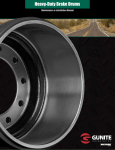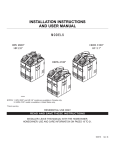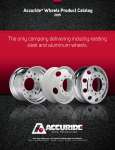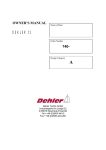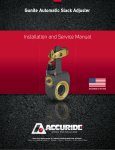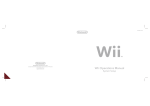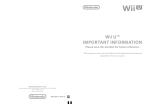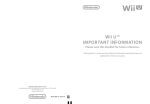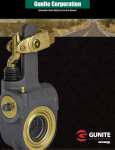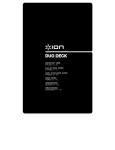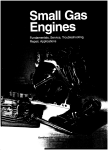Download Gunite Brake Drums - Accuride Corporation
Transcript
Gunite Brake Drums Maintenance and Installation Manual Your only single source for industry-leading wheel end solutions. STEEL & ALUMINUM WHEELS | DRUMS | HUBS | ROTORS | SLACK ADJUSTERS Since 1923, Gunite has been designing and manufacturing brake drums for the heavy-duty commercial vehicle industry. Today, Gunite continues to be the industry standard with brake drums as standard equipment with more OEMs than any other brake drum manufacturer. In order to maximize the service life of your Gunite brake drums, proper installation, periodic inspection, and maintenance procedures must be followed. The information contained in this manual will help in establishing a brake drum maintenance program that will help you spot problems and take the necessary corrective measures to restore balanced braking and ensure safe, reliable brake system performance. When and How to Inspect Brake Drums Consistent, reliable brake system performance is dependent on a sound brake system maintenance program. It is important that regularly scheduled inspections of the brake system are incorporated into your preventative maintenance program. By incorporating a regular brake inspection program your cost-per-mile will be significantly reduced. Costly downtime can be reduced by spotting problems before they take a vehicle out of service for extended periods of time. While there is no specific recommended timetable for brake system inspection, we recommend that you establish a regular and thorough inspection procedure to ensure consistent, reliable brake performance. Following are some of the more common problems encountered during regular brake drum inspection and the recommended procedures for correcting the problem. Cracked Drums Upon inspecting the drum, a crack extending through the entire wall is found. This condition is caused by excessive heating and cooling of the brake drum during operation. If this condition is found, the drum MUST be replaced immediately. Repeated cracking of brake drums may indicate that the brake system and/or the brake drums are inadequate for the particular application. This condition may also indicate driver abuse, particularly if the drums, lining, and brake system are correctly rated for the vehicle and the application. If this problem occurs, the brake system should be checked for proper brake system balance and proper brake lining friction ratings as recommended by the OEM. If this problem occurs on a new drum, cause may be from mishandling. Heat-Checking Heat-checking is the appearance of numerous short, fine, hairline cracks on the braking surface of the drum. Heat-checking is a normal condition found on brake drums and is caused by the constant heating and cooling of the braking surface, which occurs as the brakes are applied during normal operation of the vehicle. Heat-checks will frequently wear away and reform as a result of the normal braking process however, heat-checks can progress over time into cracks in the braking surface depending on such factors as lining wear rate, brake system balance, and how hard the brakes are used. Normal heat-checking does not impair braking performance, however, it is advisable to make sure that deep cracks have not developed. Replace the brake drum if any of the following conditions are found: heat checks where one or more extend completely across the brake surface or deep cracks are present. 1 Grease-Stained Drums If this condition exists, the brake drum will show discolored spots on the braking surface, with oil and/or grease spattered on the brake assembly. This condition is most likely caused by a faulty lubrication system or improper greasing of the brake cams. To correct the problem, the source of the grease and/or oil must be located and necessary repairs made to eliminate the leak. Remove the entire brake assembly and clean each component thoroughly. If the linings are soaked with oil or grease they must be replaced. Martensite Spotted Drums This problem may be indicated by hard, slightly raised dark colored spots on the braking surface with uneven wear. This problem may also be indicated by a pulsating ride upon brake application or excessive noise upon braking. This condition indicates that the drum has been subjected to extremely high temperatures caused by an improperly balanced braking system, a dragging brake, or continued severe brake applications. These extremely high temperatures have caused structural changes to occur in the drum material which makes the drum more susceptible to cracking. If this condition exists, the drum must be replaced. The brake linings should be checked for uneven wear and replaced if necessary. After replacing the brake drum, the entire braking system should be checked for proper balance between the tractor and the trailer as well as wheel to wheel (i.e., air distribution, brake adjustment, and power A/L factors). Scored Drums This problem is indicated by a defined, grooved appearance on the braking surface of the drum and excessive lining wear. If the scoring is severe and the drum is within the recommended inside diameter limitation (see note below), then the drum could be machined to remove the scoring. After reinstalling the brake components it is advisable to check the brake system to determine if there is excessive amounts of abrasive material entering and building up on the braking surface of the drum. NOTE When checking brake drum diameter for wear, the diameter should not exceed 0.120" over the original diameter. When reboring brake drums, the finished diameter should not exceed 0.080" over the original diameter. Blue Drums A drum which shows the signs of bluing has been subjected to extremely high temperatures. This condition may be caused by continued hard stops, by brake system imbalance, or improperly functioning return springs. It is not necessary to resurface or replace the drum as long as it remains within the allowable tolerance for operation. To correct this problem the brake system should be checked for proper balance. The return springs should be checked to determine if they are weak or broken. The brake should be checked for proper adjustment and clearance. If this condition is left unresolved, it can result in the development of a martensite condition or cause the drum to crack. 2 Polished Drums A polished drum can be identified by the mirror-like finish on the braking surface. This problem can easily be solved by sanding the braking surface with 80 grit emery cloth. It is also necessary to remove the glaze from the linings at the same time using the 80 grit emery cloth. The brake system should be checked for lightly dragging brake(s). The linings should also be checked to make sure that they have the correct friction rating. NOTE It is a recommended procedure to sand the braking surface of the drum at the time of relining. Excessive Wear If excessive wear occurs along the edges of the lining contact area of the braking surface or in areas coinciding with the lining rivet holes, the system should be checked to make sure that there is not an abnormal build-up of abrasive material. The most common cause of this problem is the build-up of abrasive material from either the presence or absence of dust shields depending on the application of the vehicle. If the problem occurs while dust shields are installed, remove the lower dust shield to allow abrasive materials to more readily exit the braking system. If the problem occurs when dust shields are not employed, install dust shields to restrict abrasive materials from entering the braking system. Brake drums should also be checked for evidence of scoring. If the braking surface diameter is in excess of maximum allowable tolerances, the brake drum MUST be replaced. Worn Mounting Surface Rounding over of the drum-mounting surface is caused by continued operation with a loose wheel assembly. If this condition is left uncorrected it will cause the wheel bolts to break resulting in wheel-end failure and the loss of the wheel assembly. To check for this condition use a straight edge and a feeler gage as shown. If the wear exceeds 0.030", the drum must be replaced along with all wheel bolts in the assembly. NOTE When checking brake drum diameter for wear, the diameter should not exceed 0.120" over the original diameter. When reboring brake drums, the finished diameter should not exceed 0.080" over the original diameter. Out-Of-Round Drums This condition exists when the drum diameter shows variations at different points around the braking surface and the brake linings exhibit more wear on one side than the other. This distortion of the drum as a result of excessive heat generated during brake applications or as a result of improper drum storage techniques (see proper drum storage recommendations on page 6 of this manual). Other possible causes for this condition include improper chucking of the drum during turning or it could be the result of dropping the drum on a hard surface during routine wheel-end maintenance. If the diameter of the drums braking surface is within allowable limitations (see note), the drum can be machined to restore concentricity. If the drum diameter is past the recommended limitations, the drum MUST be replaced. 3 NOTE When checking brake drum diameter for wear, the diameter should not exceed 0.120" over the original diameter. When reboring brake drums, the finished diameter should not exceed 0.080" over the original diameter. Oversized (Worn) Drums This condition is indicated by either excessive wear at the lip (outer edge of the drum) or improper lining to drum contact during brake application. To check, use a drum gage as shown to measure the diameter of the drum at least 1” from the lip or outer edge of the braking surface. If the measurements exceed the allowable limitations (see note), the brake drum can be machined to restore concentricity. If the drum diameter is past the recommended limitations, the drum MUST be replaced and new linings should be installed. NOTE When checking brake drum diameter for wear, the diameter should not exceed 0.120" over the original diameter. When reboring brake drums, the finished diameter should not exceed 0.080" over the original diameter. Improper Application Of Brake Drum Linings protruding past the braking surface This condition can be identified by visually inspecting the brake assembly for evidence of the lining protruding past the outer edge of the braking surface as shown at left. If this condition exists, check the hub application specifications to determine the proper drum for the application and replace the drum and install new linings if the old linings are damaged. Broken mounting ring This problem can be identified by the presence of fractures or cracks around the bolt circle or mounting surface of the drum. This condition is caused by interference between the hub and drum-mounting surface due to improper seating of the drum on the hub pilot during installation or by installing a drum with a mounting ring diameter smaller than the hub pilot diameter. If this condition is present, the drum MUST be replaced. Check the application specifications to determine the proper drum for the application before attempting to install a replacement drum. Radial cracking of the bolt holes on the mount surface This condition is caused by interference between the hub and drum-mounting surface during installation as a result of using the wrong drum for the application or improperly cleaning the hub piloting surface prior to drum installation. If this condition exists the drum MUST be replaced. Check the application specifications to determine the proper drum for the application before attempting to install a replacement drum. Before attempting to re-install another brake drum, visually inspect the hub-piloting surface and make sure that all dirt and corrosion are properly removed. Also, take care when installing the drum to make sure that the drum-mounting surface is properly and evenly seated against the hub mounting surface before torquing the wheel nuts during re-assembly. 4 Proper Selection of New Drums When replacing a worn-out or damaged drum, certain procedures should be followed to ensure that you choose the right replacement drum and that it is installed properly. Brake compatibility is extremely important in that each brake on the vehicle must perform equally to effectively produce a balanced and controlled stop. Proper Matching of Brake Assemblies Will • A description of any other markings appearing on the outer drum surface In the event this information is not available, the following information will be required in order to determine the proper brake drum for your vehicle: • Name of the vehicle manufacturer • Maximize your brakes stopping performance • Model of the vehicle • Provide longer service life between overhauls • Manufacturer and model number of the axle • Minimize brake maintenance costs • Manufacturer and model number of the associated wheel and hub Proper Brake Drum Selection is Key to Maintaining Optimum Brake System Performance When specifying replacement brake drums, the following information will be required: • The manufacturer’s name • The manufacturer’s part number • Brake size and type of actuation (S-Cam, Wedge, Air, or Hydraulic) • Both ends of a common axle MUST be in the same state of repair. If the brake shoes on one end are replaced, the shoes on the other end should also be replaced. If one drum on an axle is turned or replaced, the other drum should also be turned or replaced to maintain consistent braking performance. Sizing of a Brake Drum 1 If the information previously described is not available, it will be necessary to take accurate measurements and gather the information as described in steps 1 through 7. Braking surface diameter 2 Width of braking surface 5 Bolt circle diameter 3 4 Overall depth of the drum 6 Pilot diameter 7 Number, size, and location of bolt holes 5 Are there slots in the back of the drum for wheel spoke clearance? Factory Balanced Brake Drums Gunite makes two types of factory balanced brake drums, machined-to-balance and traditional welded balance weights. Both styles are balanced to the same factory specifications (10 inch ounces - front axle and 20 inch ounces - rear drive and trailer axle) and will provide identical performance. When ordering replacement drums or installing new drums during normal brake service, it is acceptable to interchange machined-to-balance with traditional welded balance drums. Welded balance weight Machined-to-Balance Proper Storage of Brake Drums Many fleets maintain an inventory of brake drums for routine replacement. The proper storage and handling of these drums will ensure optimum performance and longer service life. Correct Storage Method Incorrect Storage Methods Drums should be stored in an area free from excess moisture and stacked as shown in Figure 1, to ensure proper distribution of weight on the sidewalls of the drum. Properly stacking new drums will avoid distortion of the sidewalls or damage to the braking surface. Storing brake drums by “nesting” one drum in another without a designed stacking feature or resting the drums on their side “book end”, as shown in Figure 2, will result in damage to the drums. Storing drums in any of these ways will cause an out-ofround condition to occur which will require machining to restore concentricity before installation. This will significantly reduce the service life of the drum and create unnecessary expense due to the machining of a new drum. Figure 2 Figure 1 6 Installing New Brake Drums When installing new brake drums, it is advisable to check all components of the brake system for wear and thoroughly clean them prior to installing the new drum. The brake system should also be checked for proper adjustment and balance to ensure proper operation. Hub Piloted vs Ball Seat Drums It is important to make sure that the correct hub and drum combination is used when replacing wheel-end assemblies. Incorrect or mismatched parts may result in loose or broken mounting studs or wheel-ends which can result in an accident. If you are unsure about the correct combination for your application, contact the manufacturer for the correct part numbers and styles. Older ball seat mountings have a close fit between the drum stud holes and stud diameter. The drum is installed on the hub pilot. The wheels are piloted on the studs using inner and outer cap nuts. (see Figure 3) Figure 3 – A ball seat disc wheel mount Hub piloted mountings have a close fit between the drum pilot and the machined pilot (continuous or interrupted) on the hub. The drum bolt mounting holes are larger than the stud diameter. The wheels and drum are piloted on the hub. (see Figure 4) New drum designs will allow you to use the same drum for ball seat and hub piloted applications when matched with the proper hub. These new drums cannot be used with older hubs which have a different pilot diameter. Matching the drums with the proper hub is critical in providing and maintaining the support of the wheel-end. Figure 4 – A hub piloted disc wheel mount 7 How to Properly Install an Outboard Mounted Brake Drum 1. Before installing drum, make sure that the brakes are in the fully released position to provide enough clearance over the brake shoes. Position the hub pilots to be in the 12 o’clock location as shown. Note: It is very important to make sure that the pilots are clean and free from rust or any other foreign material. 2. Install drum over the wheel bolts and onto hubs drum pilot, insuring that it is flush against the hub flange. Care must be taken to avoid damaging the wheel bolt threads when mounting drum. 3. Proceed with mounting wheels making sure to follow proper wheel nut torque sequence and torque specifications per Accuride’s Rim/Wheel Safety and Service Manual (W3.000) Do not forget to properly adjust the brakes. 8 4. After final assembly, visually inspect drum mounting and verify there are no gaps between the hubs drum pilot and the drum. Check for any unusual gap differences between brake lining and drums brake surface. Mounting Gunite Brake Drums on “Hub Piloted” Wheel-end Assembly Gunite drums are designed with different pilot chamfers where the drum fits the pilot. If corrosion builds up behind the chamfer (point “X” in Figure 5) and a drum with a smaller chamfer (point “Y” in Figure 5) is installed without removing the corrosion from the hub, the drum will not set properly and the mounting flange may break when the assembly is torqued. Therefore, it is necessary that you thoroughly clean the hub mounting surface using a scrapper and wire brush before attempting to mount a new brake drum. This is especially important if you are mounting brake drums on a wheel-end assembly using an aluminum hub. Figure 5 – A Hub Pilot Chamfer Special Considerations for Mounting Brake Drums on Aluminum Hubs Unlike traditional cast iron hubs, the surface on the drum pilot of an aluminum hub is susceptible to damage if the drum is not properly seated during the installation process. If the drum is improperly installed and allowed to rest on the wheel pilot, the drum pilot surface will be damaged when the assembly is torqued down. This will not allow the drum to properly seat, resulting in damage to the hub and may also result in a dragging brake condition. (See Figures 6 and 7 below) Figure 6 – Improper installation, drum is cocked and not properly seated on the drum pilot of the hub. Figure 7 – Proper installation, drum is correctly positioned on the drum pilot and flat against the hub flange. Disc Wheel Mounting Gunite has standardized the drum mounting bolt hole sizes on outboard mounted drums. The bolt hole size on drums mounted on the front steerable axle is 1-1/4". The bolt hole size on drums mounted on the rear drive axle and trailer axles is 1". In some applications, where smaller studs are used, a clearance may exist between the bolt hole diameter and the stud. This condition is not a problem because the drum will be centered by the hub pilot and will be held in place when the wheel is torqued against the drum. When the proper mounting hardware is used and the recommended wheel torque (see chart on next page) are maintained, the drum will be held securely in place. 9 1-1/4" Bolt Hole Front Steer Axle Application 22mm Wheel Bolt 1-1/8" Wheel Bolt 1" Bolt Hole Rear Drive and Trailer Axle Application 3/4" Wheel Bolt 22mm Wheel Bolt Disc Wheel Mounting Torque Mounting Type Nut Thread Torque Level Ft. Lbs. (oiled)* Mounting Type Nut Thread Torque Level Ft. Lbs. (dry) 11/16" - 16 300 - 400 450 - 500 M20 X 1.5 280 - 330 Stud piloted, double cap nut standard type – 7/8” radius 3/4" - 16 Hub piloted with flange nut 1-1/8" - 16 450 - 500 M22 X 1.5 450 - 500 * Apply two drops of SAE 30W oil to the point between the nut and the flange and two drops of SAE 30W oil to the last two or three threads at the end of each stud. Stud piloted, double cap nut heavy-duty type – 1-3/16” radius 15/16" - 12 750 - 900 1-1/8" - 16 750 - 900 1-5/16" - 12 750 - 900 NOTE Never lubricate wheel, nut ball seats or mounting faces. If lubrication is desired, it must be used sparingly only on the threads of the studs and/or nuts. If lubrication is used, consult the wheel manufacturer for torque recommendations. 10 Trouble-Shooting Driver Complaints In some instances, drivers may complain of braking irregularities between normal or routine brake system inspections. The following list is comprised of some of the more common driver complaints, the cause, and the action required to solve the problem. Should driver complaints arise, it is advisable to inspect the braking system at the earliest possible time. Driver Complaint Common Cause Solution Driver complains of pulsating ride or excessive vibration during normal operation of the vehicle. This problem may be caused by any one of or, a combination of, the following problems: Suspension, wheel base, cab mounting, frame, out-of-round tires and/or wheels; out-of-balance tire, wheel, brake drum, or hub. Improper mounting of hub piloted drum. If it is determined that the problem results from an unbalanced brake drum or wheel, the component can be balanced in the field or a new replacement part may be ordered from the factory prebalanced. Worn mounting surface on the drum as a result of loose wheel assembly. If the exterior of the drum is covered with rust, scale, dirt, tar or other foreign material, remove with a wire brush and clean with kerosene. Then wipe and thoroughly dry the drum before reinstallation. If the drum has been improperly mounted on the hub pilot, remove and check the hub and drum for any damage. Reinstall the drum properly. Driver complains of excessive fade. Braking power diminished or is completely lost during brake application. Driver complains of brakes pulling during application, causing swerving to the left or right. Any brake lining will eventually fade when subjected to high temperatures, such as instances of repeated quick stops from high speeds or during long periods of downhill braking. This problem can be caused by inferior linings which may suffer some chemical breakdown under extended periods of high temperature. A high quality brake lining will fade gradually allowing the driver time to increase braking pressure and maintain control of the vehicle. When excessive fading occurs, the braking system should be checked for one or more of the following problems: Check the braking system to ensure that the entire system is properly balanced and that all brakes are functioning properly. Check the individual brake drums for the existence of martensite, bluing, drum distortion, or an out-ofround drum. Other causes may include oversized drums, worn or improperly rated linings. Excessive fade can also be caused by drums which expand to the point of maximum shoe travel during extended periods of excessive heat. This reduction of contact between lining and braking surface results in a loss of braking power. Check the drums for grease stains. If grease stains exist, clean the entire assembly, repair the broken or faulty component causing the leak, replace the lining if required and clean the braking surface of the drum. Pulling to the left or right during brake application can be caused by either unequal braking force (unbalanced braking system) or improperly functioning brake components. When this problem occurs, the braking system should be checked for one or more of the following causes: The braking system should be checked for balance to make sure that all brakes are functioning equally during the brake application. Check the slack adjusters to make certain that they are functioning properly and that the proper clearance is present between the lining and the braking surface. Individual brakes should be checked for worn or damaged brake linings or other broken or damaged parts. Brake drums should be checked for excessive wear or specific damage to the braking surface. Drums should also be checked for the presence of abrasives or foreign matter in the drum. Driver complains of excessive noise, chattering, or pulsating during brake application. These problems can be caused by one or more of the following problems. The existence of bluing, a martensite condition, or grease spotted, polished drums, excessive wear at the rivet holes and/or at the point where the edge of the linings contact the braking surface. Other causes could include out-of-round drums, unbalanced drums, worn or damaged brake parts, or foreign matter on the braking surface. 11 The brake drums should be removed and checked for the existence of one or more of the problems described. The appropriate corrective action should be taken immediately, depending on the problem found to be the cause. ACCURIDE WHEEL END SOLUTIONS (AWES) LIMITED WARRANTY TO FILE A WARRANTY CLAIM, CALL 1-800-869-2275 ext 1 Accuride Wheel End Solutions (AWES) warrants to the original purchaser that its products are free from defects in material and workmanship. The limited warranty time-frame (reference table below) is based on the date of product manufacture and shall be void if the product is altered, modified, misapplied, misused, neglected, repaired or not maintained in accordance with the instructions printed in the product-specific Accuride Wheel End Solutions’ Safety & Service Manuals(2). GENERAL PRODUCT OVERVIEW Product Type Accuride Aluminum Wheels(2) Accuride Steel Wheels(2) 5 years/ 60 months 5 years/ 500,000 miles(1) 1 year/ 12 months 3 years/ 350,000 miles(1) 3 years/ 300,000 miles(1) Industry Standard Aluminum wheels Duplex® Aluminum Wheels ACCU-SHIELD® Wheels ACCU-ARMOR™ Wheels 2 years/ 200,000 miles(1) Limited Warranty ACCU-FLANGE™ Wheels Duplex® Steel Disc Wheels Duplex® Demountable Rims Tube-Type Wheels & Demountable Rims Light Truck Wheels Steel Bolt-Together Specialty Wheels Extra Service Wheels™ (ESW) Styled Steel Wheels Tubeless Wheels and Demountable Rims Gunite Slack Adjusters(2) Over-The Road/ Line Operated Trucks and Trailers Gunite Hubs(2) TRU-SET® Trailer School Bus/City Delivery Vehicles TRU-SET® Front/ Steer TRU-SET® Rear/ Drive Severe Service: Garbage/Refuse Trucks, Fire Trucks, Logging, etc. Industry Standard Hubs Gunite Brake Drums(2) Industry Standard Brake Drums Gunite Disc Brake Rotors(2) Industry Standard Disc Brake Rotors Gunite Spoke Wheels(2) Industry Standard Spoke Wheels (1) Time or miles, whichever occurs first (2) Refer to appropriate Accuride Wheel End Solutions guide for additional limited warranty condition details: Accuride Rim/Wheel Safety & Service Manual, Gunite Heavy-Duty Brake Drums, Gunite Automatic Slack Adjuster Service Manual, Gunite Disc Brake Rotors Maintenance Manual, and Gunite Disc Wheel Hubs, High-Performance Hubs, and Spoke Wheels Maintenance & Installation Manual 12 ACCURIDE WHEEL END SOLUTIONS (AWES) LIMITED WARRANTY TO FILE A WARRANTY CLAIM, CALL 1-800-869-2275 ext 1 ADDITIONAL PRODUCT SPECIFIC LIMITED WARRANTY CRITERIA Wheels: The above warranty shall be void if the product is used with improper tire sizes, inflation pressures, or exceeded load ratings. The above warranty shall be void if the product is not properly maintained in accordance with the Accuride Rim/Wheel Safety & Service Manual. The above warranty also does not cover defects resulting from corrosion (except as noted above), other non-Accuride components, accident, excessive speed or other abnormal or severe operating conditions. ACCU-ARMOR™ and ACCU-SHIELD®: AWES does not cover the following conditions: (i) Any damage in the areas of the mounting surfaces, such as the area under the mounting nuts, the area in contact with hubs or drums and the area in contact with other wheels in dual position, (ii) Any damage due to cleaning, including damage from the use of abrasives, abrasive brushes, steel wool, scouring pads or strong chemicals, and (iii) Any damage to the wheel finish due to removal, misuse, or chipping, whether by contact with road obstacles such as stones, gravel, curbs, barriers, signs, or otherwise. ACCU-SHIELD® products are not covered for corrosion. AWES recommends cleaning wheels with mild soap and water. ACCU-FLANGE™: The Accu-Flange treatment warranty covers original purchasers against sharp edges on the rim flange for two (2) years from the date of manufacture. This warranty does not cover the following conditions: (i) Any damage due to cleaning, including damage from the use of abrasives, abrasive brushes, steel wool, scouring pads, strong chemicals or corrosives, and (ii) Any damage due to removal, misuse, or chipping, whether by contact with road obstacles such as stones, gravel, curbs, barriers, signs, tire changing equipment, or otherwise. For Accu-Flange / Accu-Shield or Accu-Flange / Accu-Armor wheels, AWES recommends cleaning with mild detergent and water only. For Accu-Flange only wheels, AWES recommends cleaning with mild detergent and water and then apply a wheel polish or carnauba wax with 100% cotton cloth. Standard Brake Drums, Spoke Wheels, Disc Wheel Hubs, Automatic Slack Adjusters, and Hardware: The above warranty shall be void if (i) any goods have exceeded AWES’ acceptable wear limits or have been subjected to accidents or abnormal conditions of use, temperature, moisture, dirt or corrosive matter, or (ii) the product fails as the result of another manufacturer’s product. The TRU-SET® disc wheel hub requires the use of a seller-approved hubcap and lubricant. REMEDIES AND LIMITATIONS OF REMEDIES In the event of any material breach of the above limited warranties, AWES agrees to repair or replace, at its sole option, without charge any and all of its warrantable product that fail during normal use and service due to defects in material and/or workmanship, all subject to the original purchaser providing written notice of the alleged breach within 30 days of failure. Time is of the essence herein, and original purchaser’s failure to provide written notice to AWES within the required time of any alleged breach of the foregoing warranty will release and discharge AWES from any obligation or liability for that breach of warranty. In no event will AWES be liable for any other costs associated with the replacement or repair of product covered under this warranty, including labor, installation or other costs incurred by customer. The remedies set forth herein shall be the sole and exclusive remedies available to the original purchaser so that AWES repair or replacement is a fulfillment of all AWES obligations. AWES SHALL NOT BE LIABLE FOR ANY CONSEQUENTIAL OR INCIDENTAL DAMAGES OF ANY KIND. FURTHER, UNDER NO CIRCUMSTANCE SHALL AWES BE LIABLE FOR DAMAGES BEYOND THE PRICE OF THE GOODS PURCHASED BY THE ORIGINAL PURCHASER, WHETHER IN CONTRACT, IN TORT OR UNDER ANY WARRANTY OR OTHER USE. AWES reserves the right to request product return as a condition of reimbursement. Return expense may be paid by AWES or may be reimbursed to the original purchaser if product is found to be warrantable. No goods are to be returned to AWES without a Returned Goods Authorization (RGA). If AWES determines that any of the returned goods are non-warrantable, AWES reserves the right to charge the original purchaser for the recovery of all transportation costs and expenses incurred in examining, processing and handling such goods. Any controversy or claim that customer may wish to bring that is arising out of or related to this limited warranty or breach hereof must be commenced in writing within 30 days of notification of warrantable status. Any product deemed non-warrantable is the property of the original purchaser and can be returned to the original purchaser upon its request and at its sole cost and expense. Should the non-warrantable item(s) not be reclaimed, AWES will disposition the product no sooner than 30 days after original purchaser notification has been made. For all warranty related questions, please contact your AWES warranty administrator at 1-800-869-2275 Option 1 or submit questions or claims to [email protected]. A completed warranty claim form can also be faxed to 1-815-964-0775. THE ABOVE WARRANTY IS THE SOLE AND EXCLUSIVE WARRANTY GIVEN BY AWES AND IS IN LIEU OF ALL OTHER WARRANTIES EXPRESSED, STATUTORY OR IMPLIED, INCLUDING WARRANTIES OF MERCHANTABILITY AND FITNESS FOR A PARTICULAR PURPOSE, ALL OF WHICH ARE EXPRESSLY DISCLAIMED BY AWES. IN NO EVENT SHALL THIS WARRANTY BE DEEMED TO COVER INCIDENTAL, SPECIAL, INDIRECT OR CONSEQUENTIAL DAMAGES OF ANY KIND. 13 NOTES 14 Your only single source for industry-leading wheel end solutions. STEEL & ALUMINUM WHEELS | DRUMS | HUBS | ROTORS | SLACK ADJUSTERS (800) 677-3786 / (815) 964-3301 | accuridewheelendsolutions.com Gunite | 302 Peoples Avenue | Rockford, IL 61104–7092 15 WE3.000 0914 Replaces GUN4.0001 0912 ©2014 Accuride Corporation
















